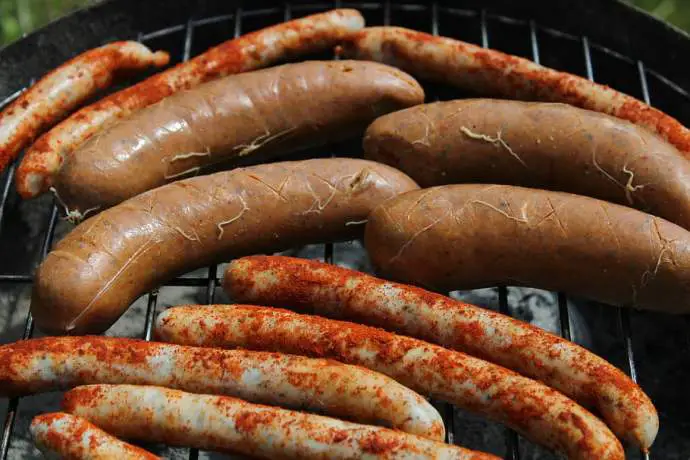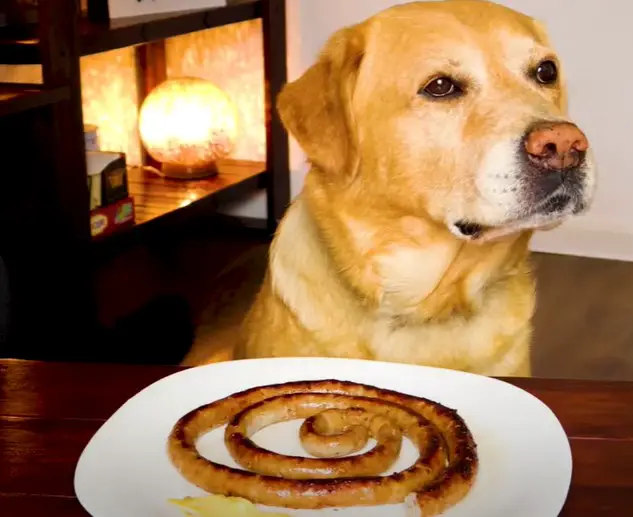Hey, do you like having sausages for breakfast or as a snack?
Sausage casings do more than just add flavor and shape, they actually help preserve the meat.
But here’s something to think about – can your furry buddy safely eat sausage casings?
Well, it’s not a simple yes or no. It depends on stuff like the type of casing and your dog’s health.
If you’re planning to give your dog a yummy treat or if you’re worried because they snuck a sausage casing when you weren’t looking, no worries! We’ve got you covered!

Table of Contents
Factors to Consider When Giving Your Dog Sausage Casings
If you want to give your furry friend some sausages, there are a few things you should consider when it comes to the casings.
Types of Sausage Casings: Natural vs. Artificial
First off, you need to know whether the casing is artificial or natural.
Natural casings are derived from animals’ intestines known as submucosa. These casings are typically very thin and, more importantly, edible. This means that your beloved dog can easily digest them without any issues.
Artificial casings, on the other hand, are crafted from various materials such as collagen, cellulose, or plastics.
Collagen casings, being one of the most common artificial options, are generally cheaper than their natural counterparts. They are also usually edible, which is a plus for your canine companion.
However, note that some thicker collagen casings may require peeling before serving them to your pup.
Unlike collagen casings, cellulose, and plastic casings are inedible and should always be removed before feeding sausages to your dog. These casings serve as protective barriers for the sausages but pose a potential hazard if consumed.
While it’s relatively easy for humans to determine whether a sausage casing is edible based on its texture and chewiness, dogs lack this discernment. They may unwittingly consume casings that are challenging to digest.
Given the risk of undigested casings, it’s crucial to inspect the sausages before serving them to your dog. Regardless of whether the casing is natural or collagen-based, a thorough check ensures your furry friend’s safety.
Even when your dog consumes an edible casing, there’s always the possibility of issues arising if the casing isn’t adequately chewed. This is particularly true for natural casings, which can be tough if not chewed properly.
If it’s your dog’s first time enjoying a sausage, exercise extra caution. Monitor them closely to ensure they handle the new treatment well and show no signs of discomfort.
Why Your Dog’s Age, Size, and Health Matter When It Comes to Sausage Casings
Did you know that your dog’s age, size, and overall health can affect how they digest certain foods, like sausage casings?
Let’s start with size. If you have a petite companion, like a Chihuahua or Pomeranian, they’re more likely to have a bad reaction to sausage casings.
But don’t assume that larger breeds are in the clear, observe them after they’ve had a sausage casing treat.
Age is another factor to consider. Senior dogs are more likely to have sensitive stomachs and experience symptoms like diarrhea, or vomiting after eating sausage casings.
And if you have a puppy or an older dog, their immune system is weaker, so it’s best to avoid sausage casings altogether.
Finally, if your dog has any existing health conditions, be careful with what you feed them.
The Problem with Sausage

If you’ve ever shared a slice of sausage with your dog, you might think it’s a harmless treat. However, understand that sausages, despite their savory appeal, can present a range of health risks for your canine companion.
High-Fat Content
Dogs, especially those with sensitive stomachs, puppies, or senior dogs, may struggle to digest the excessive fat found in sausages. Consumption of high-fat foods can lead to various digestive upsets, ranging from mild discomfort such as vomiting and diarrhea to severe conditions like pancreatitis.
Excessive Sodium
Another hidden danger in sausages is their elevated sodium content. This excess salt can pave the way for dehydration in dogs and potentially cause long-term kidney and heart damage.
Dogs that consume sausages might exhibit signs of excessive thirst, frequent urination, and in severe cases, even seizures.
Spices
Sausages often feature an array of spices, such as onions, garlic, paprika, or pepper, which can also be problematic for your dog’s digestive system. These spices can cause gastrointestinal issues, such as bloating, gas, and diarrhea.
Protein Content
While sausages are rich in protein, which is essential for your dog’s health, they’re not the best source of it. Many dog treats contain high levels of protein, and they’re specifically formulated to meet your dog’s nutritional needs.
What to Do If Your Dog Has Eaten Sausage
If you suspect that your dog’s digestive discomfort is linked to sausage consumption, prompt action is essential.
Differentiate whether it’s the sausage meat or the casings causing the issue.
If your dog displays symptoms like vomiting, diarrhea, or loss of appetite after eating sausages, don’t hesitate to reach out to your veterinarian for immediate guidance and assistance.
>Also read: How to Deal With Slimy Sausage Casing
Which Sausages Are Safe For Your Dog?

First up, we have plain old hot dogs without casing. While not all hot dogs are suitable for your pup, these ones are generally safe.
If you want to give your dog something with a bit more flavor, Andouille sausage is a great option. It’s made from pork and has a mild taste that most dogs will love.
For those with adventurous taste buds, kielbasa and chorizo sausage are also pork-based and generally safe for dogs. But keep in mind that if your dog has a sensitive stomach, it’s best to avoid these options.
Always avoid sausages with casings on. These can harm your dog’s digestive system, so make sure to remove the casing before feeding it to your pup.
Lastly, have you heard of dog sausages? These are specifically made for dogs and have a softer casing that’s easy to digest. Plus, they come in different flavors, so you can find one that your dog will absolutely adore.
Some dog sausages even help promote dental health by cleaning your dog’s teeth as they chew.
In Conclusion
While sausages with natural casings can be given to your dog, it’s always better to remove the casing or boil it before feeding it to them.
And if your dog has already eaten a sausage casing and seems unwell, seek veterinary care right away.
Keep your furry friend happy and healthy!
dog owners
lot, lot, problem, treat, problems, sausage types, read meat, sausage meat, horizontal sausage, dog, dog, dog, dog, dog, dog.

Fernando is the creator and writer behind the food blog Eating with your Hands. Living and working in cities like Paris, Barcelona, and Berlin, and being married to a Canadian foodie, has given Fernando a passion and interest in food and inspired him to run EWYH.
